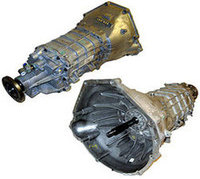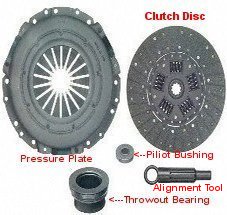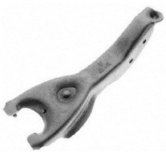
It is safe to say that proper clutch operation is what links full engine power to your manual transmission which is then funneled to drive the wheels. A clutch is a wearable item that needs maintenance if the vehicle stays in service long term.
Clutches that have become worn and not repaired can reduce power. It can also reduce fuel economy. Drivers with slipping clutches may want to put off repairs, but eventually they’ll need to be addressed. The clutch is located between the transmission and engine providing a friction coupling from the flywheel.
Power is then applied to the input shaft of the transmission. Without a strong full force application of the clutch, motion will not be what the driver expected. On this page were going to discuss how a clutch works and the names and operation of its main components. On the next page we will discuss diagnosis and repair practices for these parts.
Clutch Operation Principles

The power output from the engine is supplied by the flywheel. It is the job of the clutch disc made of a friction material similar to brake pad material to engage the flywheel and spin the input shaft of a manual transmission.
The flywheel itself is bolted to the crankshaft and balanced for smooth operation. The pressure plate is also mounted to the flywheel via strong bolts. Also note there is a bore in the center of the crankshaft that holds a pilot bushing or bearing. This supports the front end of the input shaft and maintains alignment with the engines crankshaft. The clutch disc that provides the power transfer from the engine to the transmission is controlled by the force of the pressure plate assembly.
The pressure plate is responsible for squeezing the clutch disc against the flywheel with sufficient force to translate full engine torque for proper clutch operation without slipping.
It must also move away from the clutch disc to allow disengagement from the flywheel when the clutch pedal is depressed to stop motion of the vehicle. The clutch disc is designed to absorb things like crankshaft vibration, sudden hard engagement and drive-line shock so not to damage other drive line components.
Clutch Release Bearing Operation

Often called a throw out bearing the clutch release bearing is a lubricated and sealed needle or ball bearings assembly. Its function to smoothly and quietly move the pressure plate release levers, diaphragm springs through the disengagement and applied positions.
When the clutch is engaged the release bearing slides to the rear of the main shaft that is mounted on. It is controlled by a clutch fork that is either hydraulically or mechanically connected to the clutch pedal. This allows the pressure plate to move forward and clamps the clutch disc against the flywheel with authority.
In this clutch applied position with the foot off of the clutch pedal the release bearing will stop spinning. This is important for noise diagnosis, when throw out bearing noise is suspected. A noise from a throw out bearing is most evident with the clutch pedal pushed to the floor and the disc released from the flywheel.
The clutch release bearing noise diagnosis should be performed with the manual transmission in the neutral position to assure that there are minimal spinning parts inside the transmission.
With the parking brake set and the manual transmission in neutral a clutch release bearing noise can be isolated by pushing on and then letting off of the clutch pedal. If the noise goes away when the pedal is released the most likely cause is a worn throwout bearing. Share this clutch operation and throwout bearing noise page or favorite.
More articles and information about Manual drive trains is available on this next page about manual clutch operation. Visiting the homepage can provide some quick incite about what other types of auto repair tools are available here. You can also find out how to ask auto repair questions.

